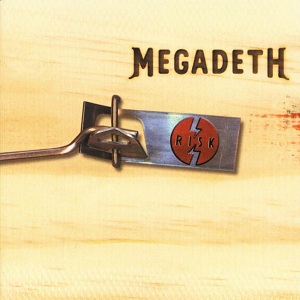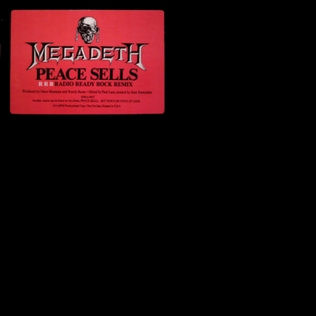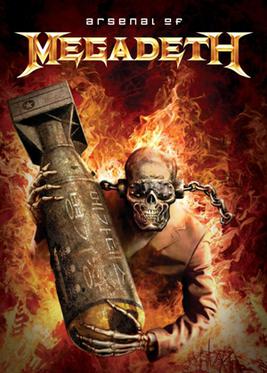
Megadeth is an American thrash metal band formed in Los Angeles in 1983 by vocalist/guitarist Dave Mustaine. Known for their technically complex guitar work and musicianship, Megadeth is one of the "big four" of American thrash metal along with Metallica, Anthrax, and Slayer, responsible for the genre's development and popularization. Their music features complex arrangements and fast rhythm sections, dual lead guitars, and lyrical themes of war, politics, religion, death, and personal relationships.

Killing Is My Business... and Business Is Good! is the debut studio album by American thrash metal band Megadeth, released on June 12, 1985, by Combat Records. At the beginning of 1985, the band was given $8,000 by Combat to record and produce its debut album. The band was forced to fire their original producer and produce the album by themselves, after spending half of the album's budget on drugs, alcohol, and food. Despite the poor production, the album was a well-received effort that obtained strong reviews in various music publications. Killing Is My Business... and Business Is Good! played an essential role in establishing thrash metal as an authentic subgenre of heavy metal music. It explores themes of death, occultism, and violence.

Peace Sells... but Who's Buying? is the second studio album by American thrash metal band Megadeth, released on September 25, 1986, through Capitol Records. The project was originally handled by Combat Records, resulting in the original mix of the album being co-produced by Randy Burns. Capitol Records then bought the rights to the album and hired another producer named Paul Lani to mix it himself. The recording of the album was difficult for the band, because of the ongoing drug issues the members had at the time. Drummer Gar Samuelson and guitarist Chris Poland were fired shortly after the album's promotional tour for drug abuse, making Peace Sells Samuelson's last Megadeth album. Poland reappeared as a session musician on Megadeth's 2004 album The System Has Failed. The title track, noted for its politically conscious lyrics, was released as the album's second single and was the band's first music video. The album's cover art, featuring the band's mascot Vic Rattlehead in front of a desolated United Nations Headquarters, was created by Ed Repka.

Rust in Peace is the fourth studio album by American thrash metal band Megadeth, released on September 24, 1990, by Capitol Records. It was the first Megadeth album to feature guitarist Marty Friedman and drummer Nick Menza. The songs "Hangar 18" and "Holy Wars... The Punishment Due" were released as singles. A remixed and remastered version of the album featuring four bonus tracks was released in 2004.

Countdown to Extinction is the fifth studio album by American thrash metal band Megadeth, released on July 14, 1992, through Capitol Records. It was the group's second studio release to feature the "classic" lineup of Dave Mustaine, Marty Friedman, David Ellefson and Nick Menza, with all of them contributing to songwriting on the album. The album features some of the band's best known songs such as "Symphony of Destruction", "Sweating Bullets", and "Skin o' My Teeth", which enjoyed significant chart success and made a great musical impact.

Risk is the eighth studio album by American heavy metal band Megadeth, released on August 31, 1999, by Capitol Records, the band's last album to be released by the label. The first Megadeth album since 1990 to feature a lineup change, Risk marks the studio debut of drummer Jimmy DeGrasso with the band, as well as the final appearance of longtime guitarist Marty Friedman, who announced his departure a year later. Meant to be a breakthrough on alternative rock radio, Risk received a mixed response because of the great deviation from the band's traditional sound. The backlash ultimately resulted in the band returning to a heavier sound on their next album, The World Needs a Hero.

David Scott Mustaine is an American musician. He is best known as the co-founder, frontman, primary songwriter and sole consistent member of the thrash metal band Megadeth and for his time as the lead guitarist of Metallica. Mustaine has released sixteen studio albums with Megadeth, sold over 38 million records worldwide, with six albums platinum-certified, and won a Grammy Award for Best Metal Performance in 2017 at the 59th Grammy Awards, for the title track of their fifteenth studio album, Dystopia.

"Peace Sells" is a song by American thrash metal band Megadeth from their 1986 album Peace Sells... but Who's Buying?, written by Dave Mustaine. The song was released as the band's second ever single in November 1986. "Peace Sells" was the group's breakthrough hit, and is regarded as one of the best songs in the history of heavy metal. Since 1985, the song has since been a constant at Megadeth concerts. According to David Ellefson, it became quickly apparent when playing the song live prior to recording the album that "Peace Sells" would be a hit. In 2006, VH1 ranked "Peace Sells" at number 11 on their list of the "40 Greatest Metal Songs" of all time. In 2023, Rolling Stone ranked the song number nineteen on their list on the 100 greatest heavy metal songs.

Chris Poland is an American guitarist, best known as the former guitarist of the thrash metal band Megadeth. Since 2002, Poland has been the guitarist of the instrumental rock/jazz fusion bands OHM and OHMphrey, among others, and has appeared on several projects and albums from a variety of different genres.

Gary Charles "Gar" Samuelson was an American musician best remembered for being the drummer for thrash metal band Megadeth from 1984 to 1987, contributing to their first two albums, Killing Is My Business... and Business Is Good! (1985) and Peace Sells... but Who's Buying? (1986). He is considered one of the most influential drummers of thrash metal, having pioneered the incorporation of jazz fusion into the subgenre.
Charles Conrad Behler is an American musician who played drums for the heavy metal band Megadeth from 1987 through 1989, recording the album So Far, So Good... So What! with the group in 1988. He also appeared in the 1988 rockumentary The Decline of Western Civilization Part II: The Metal Years. He is currently a member of Motor City Freaks.

American thrash metal band Megadeth has released sixteen studio albums, six live albums, seven compilation albums, one EP, fifty-nine singles, ten video albums, and fifty music videos. After he was fired from Metallica in 1983, guitarist and vocalist Dave Mustaine formed Megadeth along with bassist Dave Ellefson, guitarist Greg Handevidt, and drummer Richard Girod. After some initial lineup changes during 1984, Megadeth's lineup was cemented, consisting of guitarist Dave Mustaine, bassist Dave Ellefson, guitarist Chris Poland, and drummer Gar Samuelson. The band toured and gained a following, signing with the independent label Combat Records in late 1984. Megadeth's debut album Killing Is My Business... and Business Is Good! (1985), sold very well for an independent release, and the group attracted the attention of major record labels. By the end of the year, the group signed with Capitol Records. Megadeth's first major-label album, Peace Sells... but Who's Buying?, was released in 1986.

Arsenal of Megadeth is a DVD by American heavy metal band Megadeth, released on March 21, 2006 via Capitol Records. Presented as an anthology of the band's first 20 years, the two-disc DVD set contains music videos, live performances, interviews, home videos, and special appearances. As a result of licensing issues, videos from soundtrack and non-Capitol albums are not featured, save for "No More Mr. Nice Guy" and "Go to Hell" as well as despite being on Risk, "Crush 'Em" and "Breadline" were not included. The album was certified gold in the United States and platinum in Canada.

William Lee Rauch was an American drummer who played in several thrash metal bands based in California from 1983 to 1987.

Anthology: Set the World Afire is the third greatest hits album by Megadeth. It was released on September 30, 2008, through Capitol Records. It is a two-disc set with additional songs not offered in previous compilations including demos, live performances and unreleased tracks. The album's name refers to the second song of the band's third studio album, So Far, So Good... So What!.
"My Last Words" is a song by American thrash metal band Megadeth from their 1986 album Peace Sells... but Who's Buying?, written by Dave Mustaine.
"Set the World Afire" is a song by the American thrash metal band Megadeth. It is the second track from their third studio album, So Far, So Good... So What!, which was released in 1988 by Capitol Records.
The So Far, So Good... So What! Tour was a concert tour performed by the American thrash metal band Megadeth to support their 1988 album So Far, So Good... So What!. This was the only tour to feature the lineup of Dave Mustaine on vocals and guitar, David Ellefson on bass, Jeff Young on guitar and Chuck Behler on drums.
"In My Darkest Hour" is a song by the American thrash metal band Megadeth. It is the sixth track from their third studio album So Far, So Good... So What! It was released as a promotional single in 1988. The song is frequently performed live by the band. The song was featured in the documentary The Decline of Western Civilization Part II: The Metal Years, where it received a music video as well as featuring on the films official soundtrack released under Capitol. Dave Mustaine has said that the song has one of his favorite solos that he has written.














